Best Japanese Photo Translators: Only One Explains Culture [2025]
TL;DR
We tested 4 translation apps with Japan's trickiest texts:
- Complex restaurant menus
- Handwritten fortune slips
- Medicine labels
- Shrine signs
- Convenience store products
Results after 5 real-world challenges:
- Photolate: Only one that explains cultural meanings. Perfect for understanding local context.
- Google Translate: Handles basic texts but often misses Japanese nuances.
- OpenL: Good with printed text, struggles with handwriting.
- Yandex: Not recommended for Japanese.
Best Choice: Photolate if you want to truly understand Japanese culture, not just words.
Continue reading for detailed comparisons...
About This Guide
In Japan, every sign, menu, and label tells a story. But without understanding the characters, you're missing out on the real Japanese experience.
Sure, you could guess. Maybe that's sushi on the menu. Perhaps that's the exit sign. But what if you're wrong?
That's why we tested these translation apps in real Japan. No online reviews or secondhand experiences - just real-world results from:
- Actual photos in daily situations
- Head-to-head comparisons
- Unedited results - including the funny mistakes
Here's what we tested:
| Handwritten Menu | Convenience Store Product | Medicine | Street Signs | Fortune Slips |
|---|---|---|---|---|
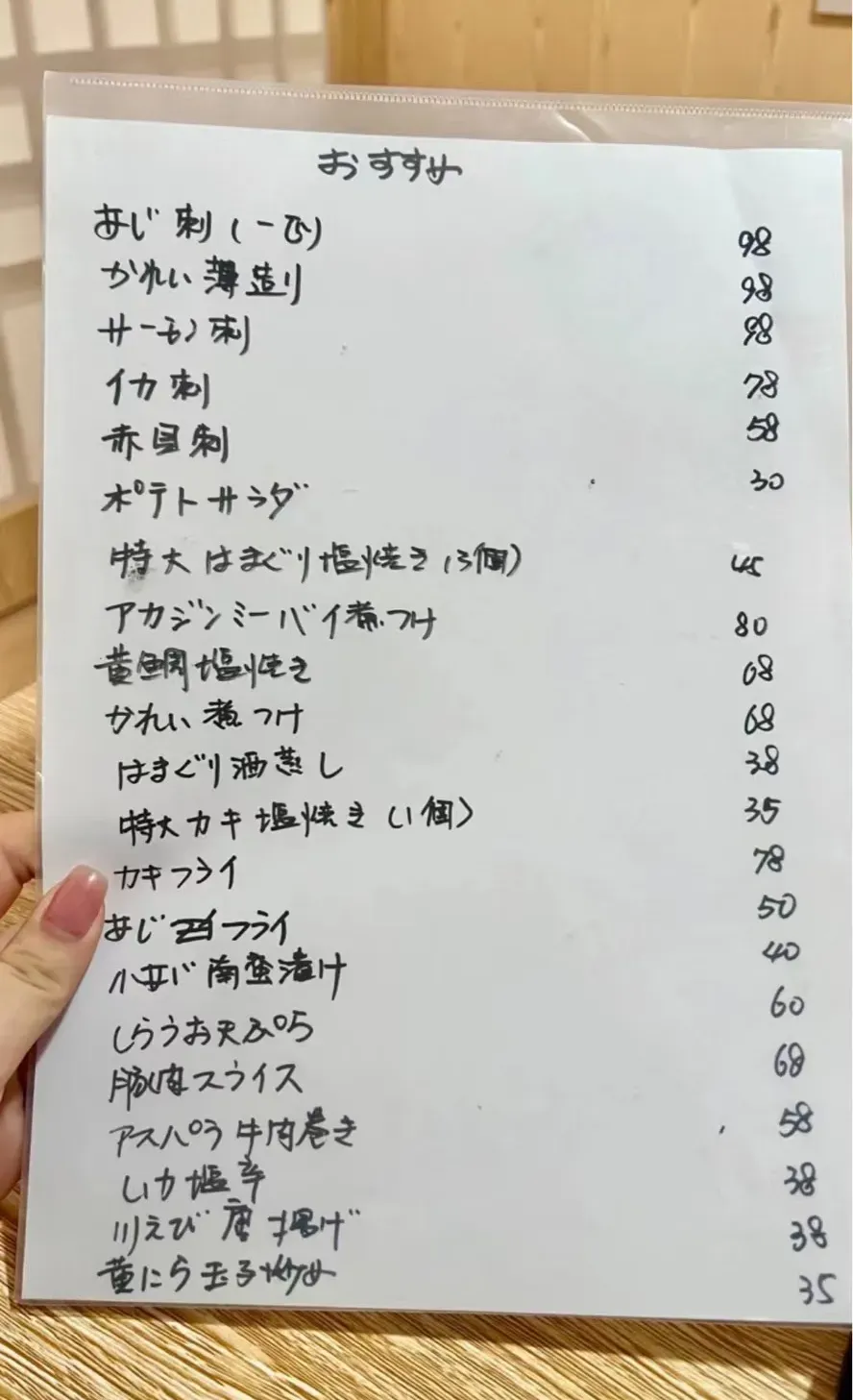 | 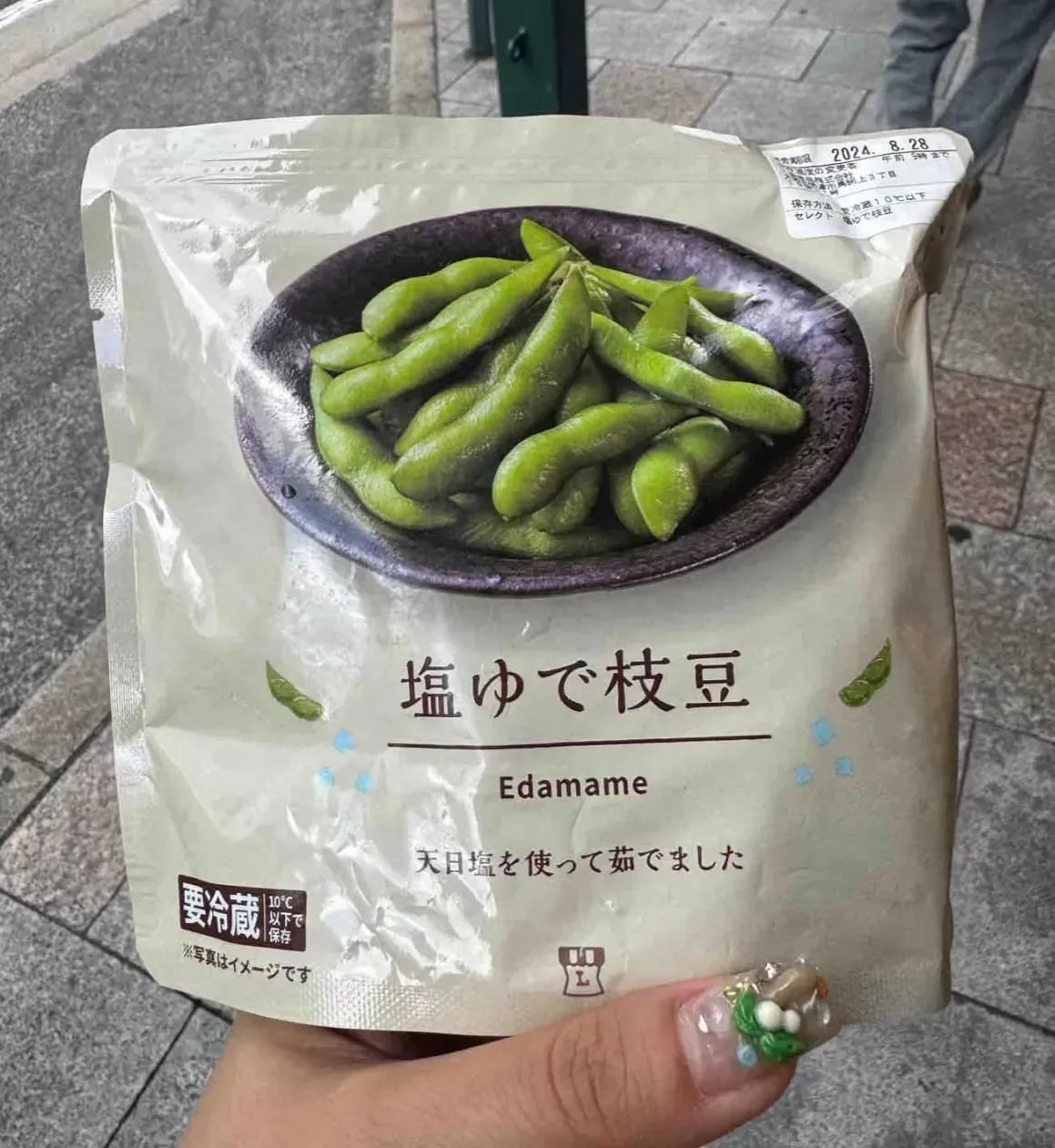 | 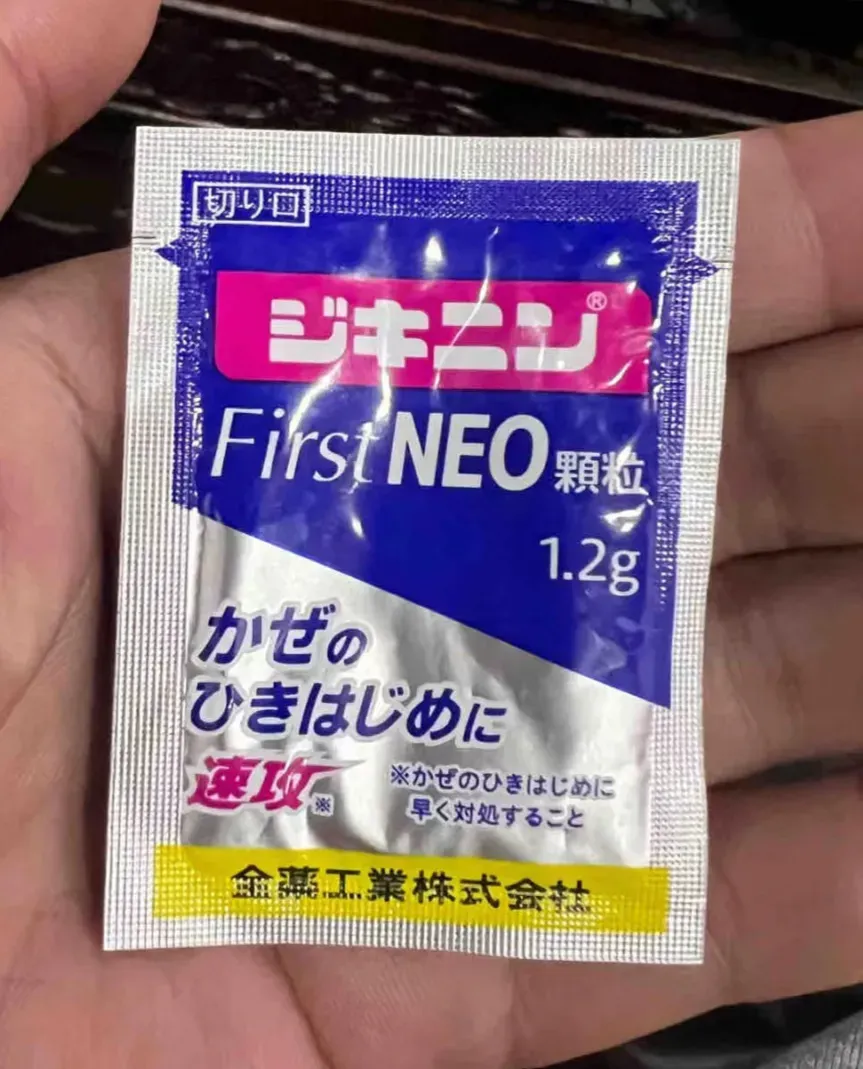 |  | 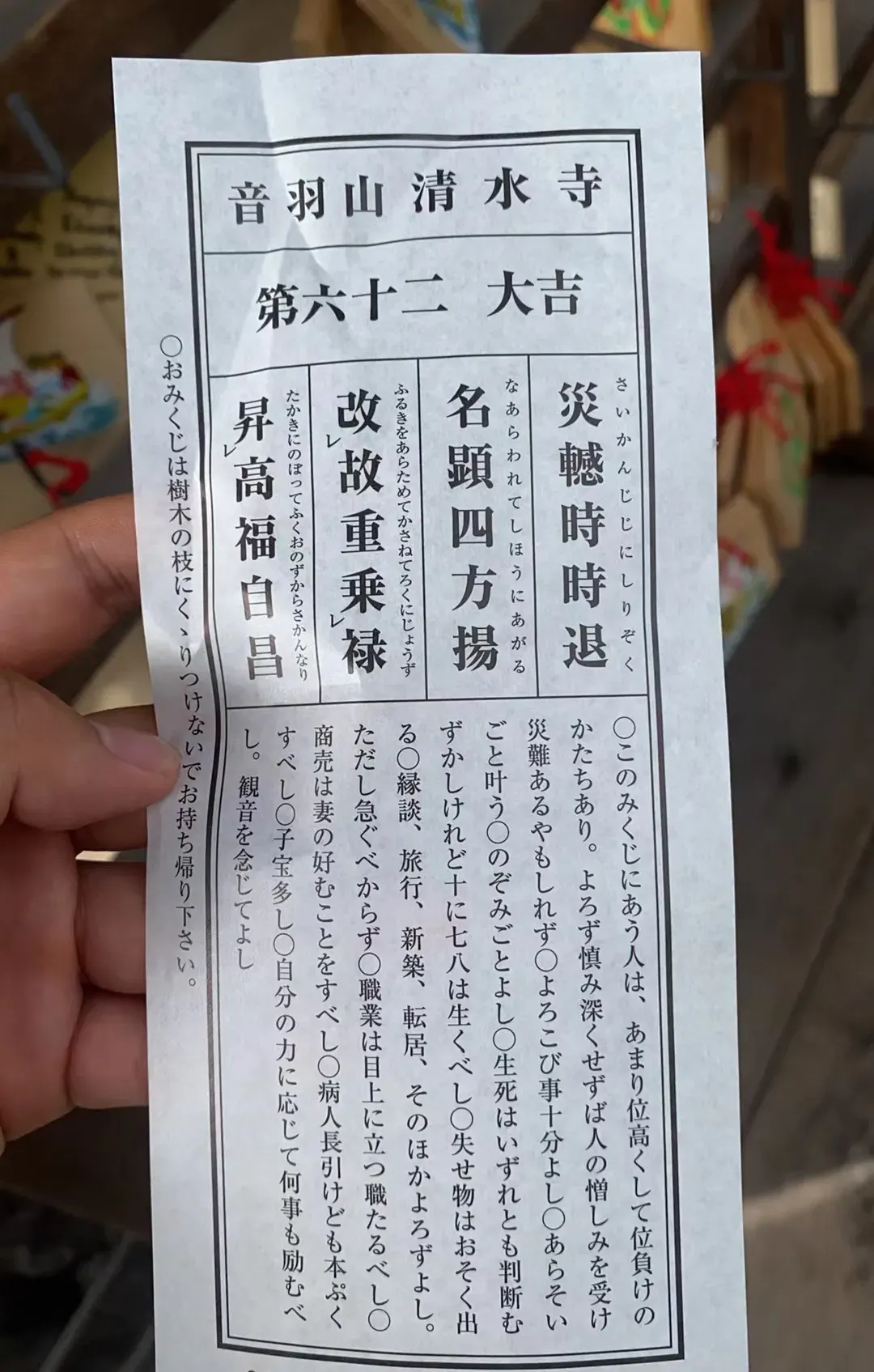 |
4 Image Translator Apps Compared
The people's champion. Everyone knows it, and it's usually the first choice for quick translations. Free, easy to use, but how well does it handle Japanese?
Popular in search results, but less known in practice. While it excels with European languages, Japanese might be a different story.
💫 OpenL
A rising star in the AI translation world. Promising features and regular updates, but can it handle real-world Japanese scenarios?
The only translator combining Microsoft's advanced OCR with GPT-4o for deep context understanding. Goes beyond word-for-word translation to capture cultural meaning.
Test 1. The Handwritten Menu 🍜
Picture this: You're in a cozy Japanese restaurant. The menu? Pure art - elegant handwriting, colorful text, and not a single picture in sight. Just you and those mysterious characters.
Let's see how our translation tools handle a typical menu board. Game on!

Now, let's see how each tool performed with our mystery menu!
| Google Translate | Photolate | OpenL Translate | Yandex Translate |
|---|---|---|---|
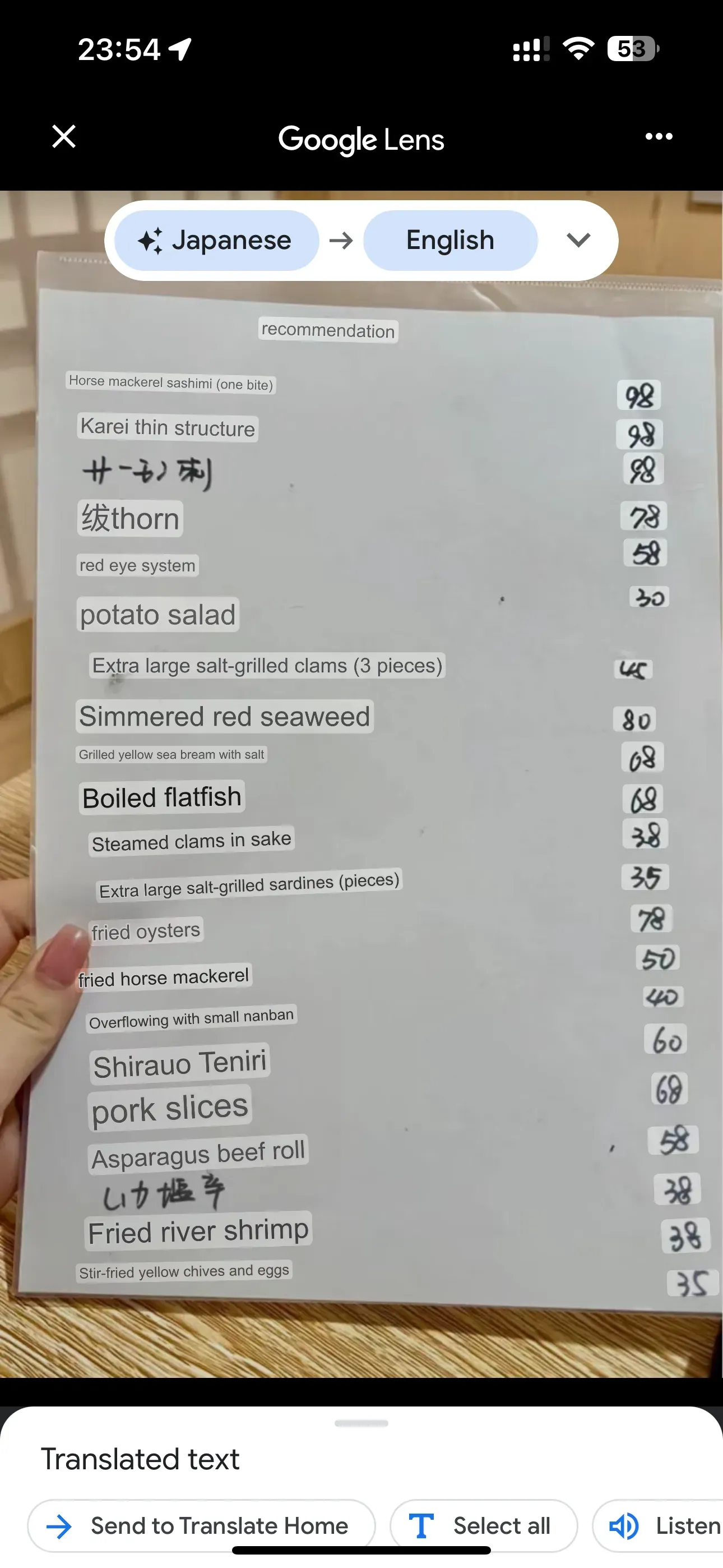 | 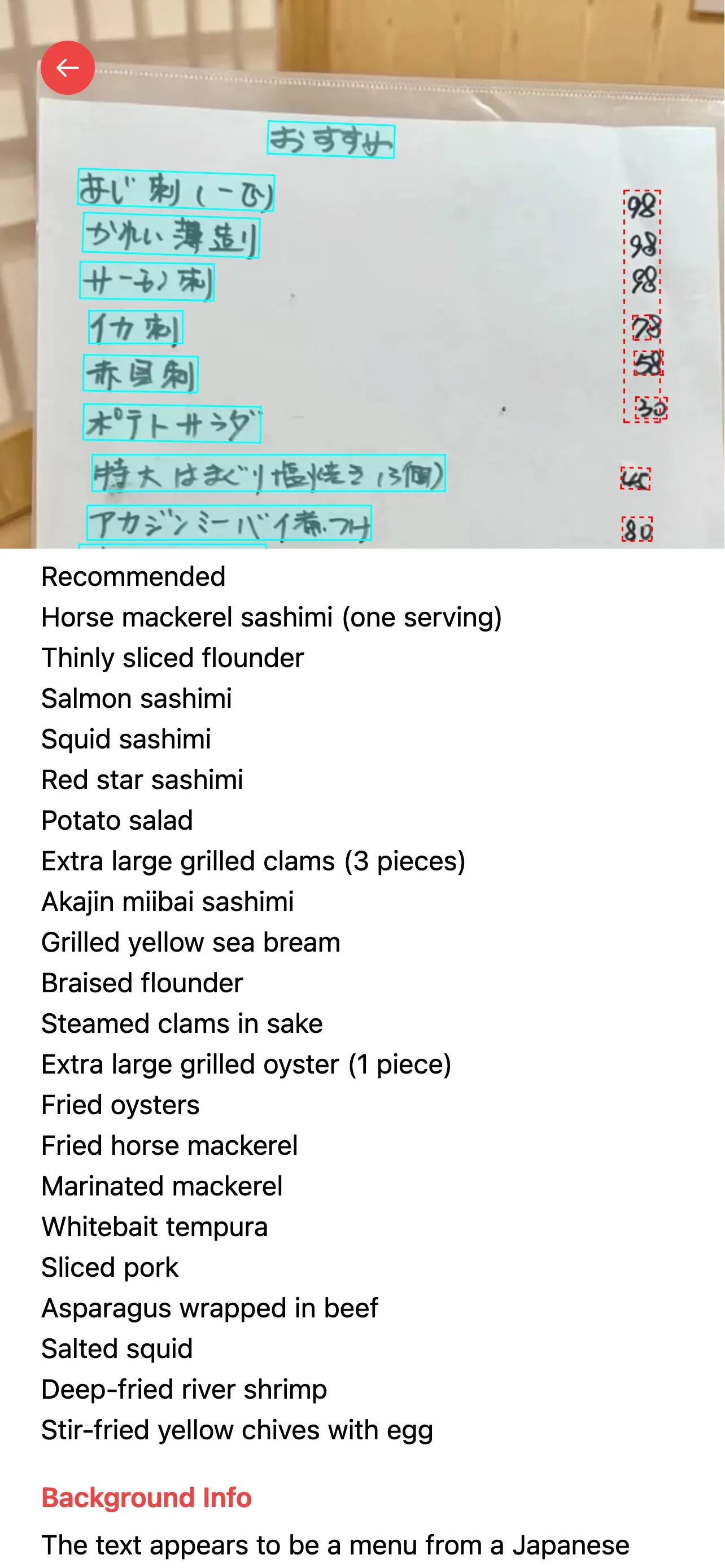 | 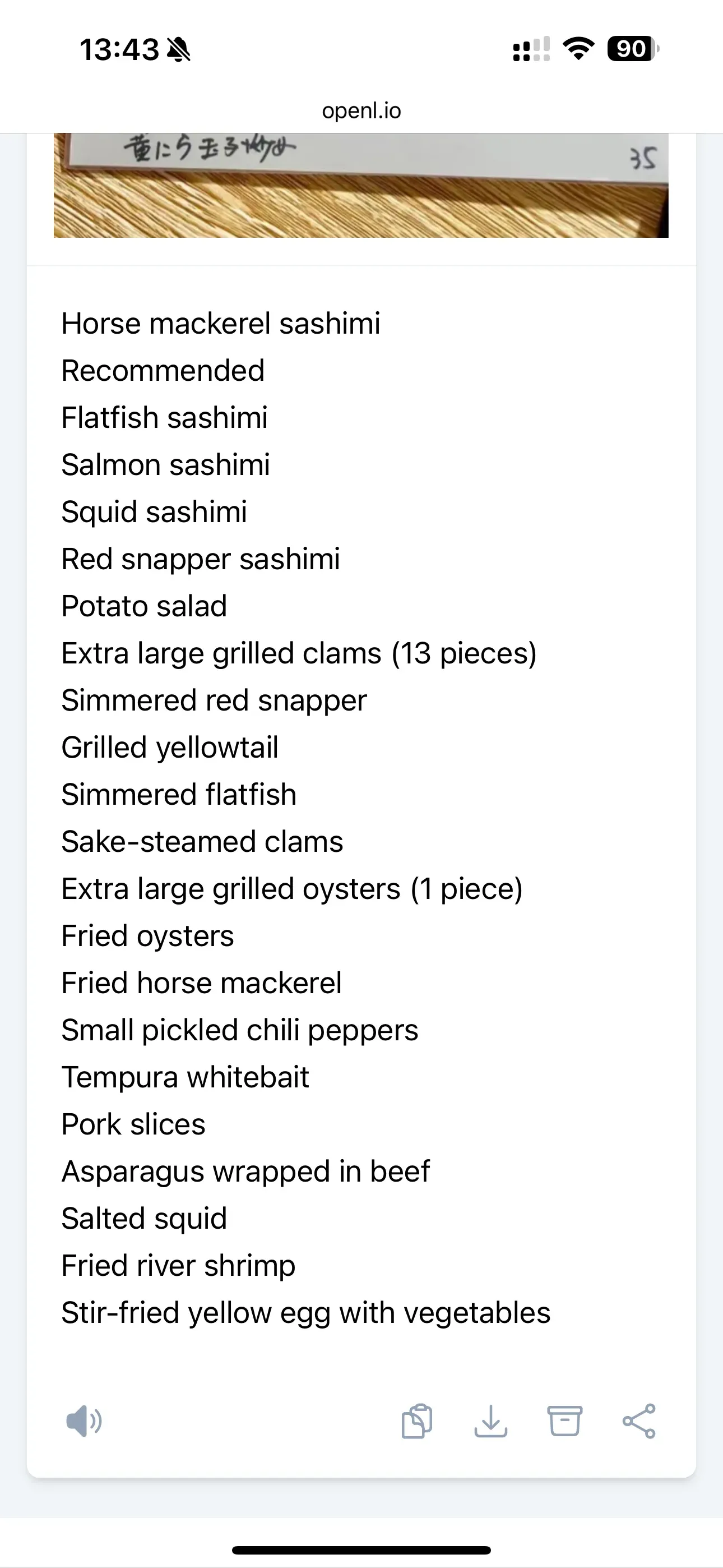 |  |
Let's break down how each translator performed with the menu items:
| Dish Name | Google Translate | Photolate | OpenL |
|---|---|---|---|
| おすすけ | recommendation | Recommended | Recommended |
| あじ刺**(**ーで**)** | Horse mackerel sashimi (one bite) | Horse mackerel sashimi | Horse mackerel sashimi |
| かれい薄造り | Karei thin structure | Flounder thinly sliced | Flatfish sashimi |
| サーモン刺 | - | Salmon sashimi | Salmon sashimi |
| イカ刺 | 绂thorn | Squid sashimi | Squid sashimi |
| 赤星刺 | red eye system | Red star sashimi | Red snapper sashimi |
| ポテトサラダ | Potato salad | Potato salad | Potato salad |
| 特大はまぐり塩焼き**(3**個**)** | Extra large salt-grilled clams(3 pieces) | Extra large grilled clams (3 pieces) | Extra large grilled clams (13 pieces) |
| アカジンミーバイフけ | Simmered red seaweed | Akajin mivai sashimi | Simmered red snapper |
| 黄鯛塩焼き | Grilled yellow sea bream with salt | Yellow sea bream grilled with salt | Grilled yellowtail |
| かれい煮つけ | Boiled flatfish | Flounder simmered | Simmered flatfish |
| はまぐり酒蒸し | Steamed clams in sake | Clams steamed in sake | Sake-steamed clams |
| 特大カキ塩焼き**(1**個**)** | Extra large salt-grilled sardines(pieces) | Extra large grilled oyster (1 piece) | Extra large grilled oysters (1 piece) |
| カキフライ | Fried oysters | Fried oyster | Fried oysters |
| あじジョフライ | Fried horse mackerel | Horse mackerel fry | Fried horse mackerel |
| ハザ南蛮漬け | Overflowing with small nanban | Haza nanban pickles | Small pickled chili peppers |
| しらうお天ぷら | Shirauo Teniri | Whitebait tempura | Tempura whitebait |
| 豚肉スライス | Pork slices | Sliced pork | Pork slices |
| アスパラ牛肉巻き | Asparagus beef roll | Asparagus beef roll | Asparagus wrapped in beef |
| いか塩辛 | - | Salted squid | Salted squid |
| 川えび唐揚げ | Fried river shrimp | Deep-fried river shrimp | Fried river shrimp |
| 黄にら玉子炒め | Stir-fried yellow chives and eggs | Yellow chive and egg stir-fry | Stir-fried yellow egg with vegetables |
Google Translate: The Mixed Bag 🤔
Handles basic items well but struggles with specialty dishes.
Gets Basic Items Right
- Simple dishes and ingredients usually translate correctly
But Sometimes it's completely lost
- "イカ刺" became "绂thorn" (What's that?)
- "赤星刺" turned into "red eye system" (Sounds more sci-fi than sushi!)
Sometimes it just gives up
- Faced with "サーモン刺" and "いか塩辛"? Just blank spaces, unable to regconize.
Photolate: Best Overall Performance 🏆
What stood out in our testing:
Accurate Menu Terminology
- The translation of "しらうお天ぷら" to "Whitebait tempura" shows deep understanding of culinary terms
- Many other apps would simply translate this character-by-character, missing the actual dish name
Precise Cooking Techniques
- Correctly distinguishes between similar cooking methods
- For example, "かれい薄造り" was accurately translated as "Flounder thinly sliced" - capturing both the ingredient and the specific preparation method
Natural Menu Language
- Translations read naturally, as you'd expect to see on an English menu
- Maintains consistency in food terminology throughout the menu
- Preserves the formality level appropriate for restaurant menus
While no translation is perfect, this tool showed the best understanding of both language and context in our restaurant tests.
OpenL: the Runner-Up 🥈
Pretty good, but not perfect.
Gets Lost in Details.
- "黄鯛塩焼き" became just "Grilled yellowtail" - missing that crucial "sea bream" part
- "ハザ南蛮漬け" turned into "Small pickled chili peppers" - missing the whole dish style
Hit and Miss Performance
- Nails simple dishes: "ポテトサラダ" → "Potato salad" (Perfect!)
- Struggles with specialties: "アカジンミーバイフけ" → "Simmered red snapper" (Missing the local nuances)
Yandex: The Early Dropout ❌
Let's just say... it wasn't ready for Japanese cuisine.
So What Makes the Difference?
Take "かれい薄造り" for example:
- Photolate: "Flounder thinly sliced" (Nailed it!)
- OpenL: "Flatfish sashimi" (Close, but not quite)
- Google: "Karei thin structure" (Lost in translation!)
The difference? Cultural know-how.
While Google Translate and OpenL do a decent job with word-for-word translation, they often miss crucial cultural context and nuances.
Test 2. The Convenience Store Product 🏪
7-11, Lawson, FamilyMart - these are your lifelines in Japan! But can our translation tools help you figure out what you're buying?
Let's test them with a simple package of edamame. Sure, you might recognize it from the picture, but what about cooking instructions and storage tips?

The Face-Off Results
| Google Translate | Photolate | OpenL Translate | Yandex Translate |
|---|---|---|---|
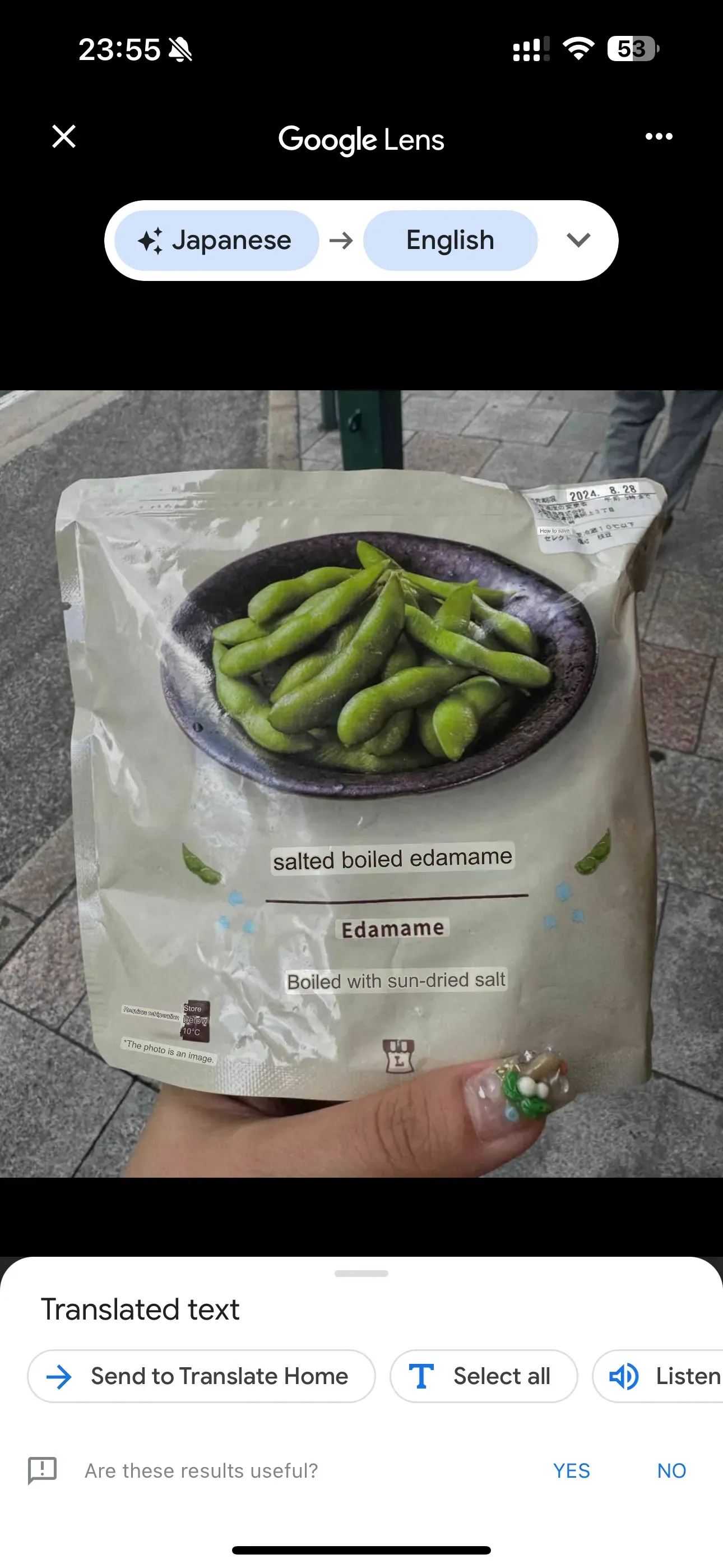 | 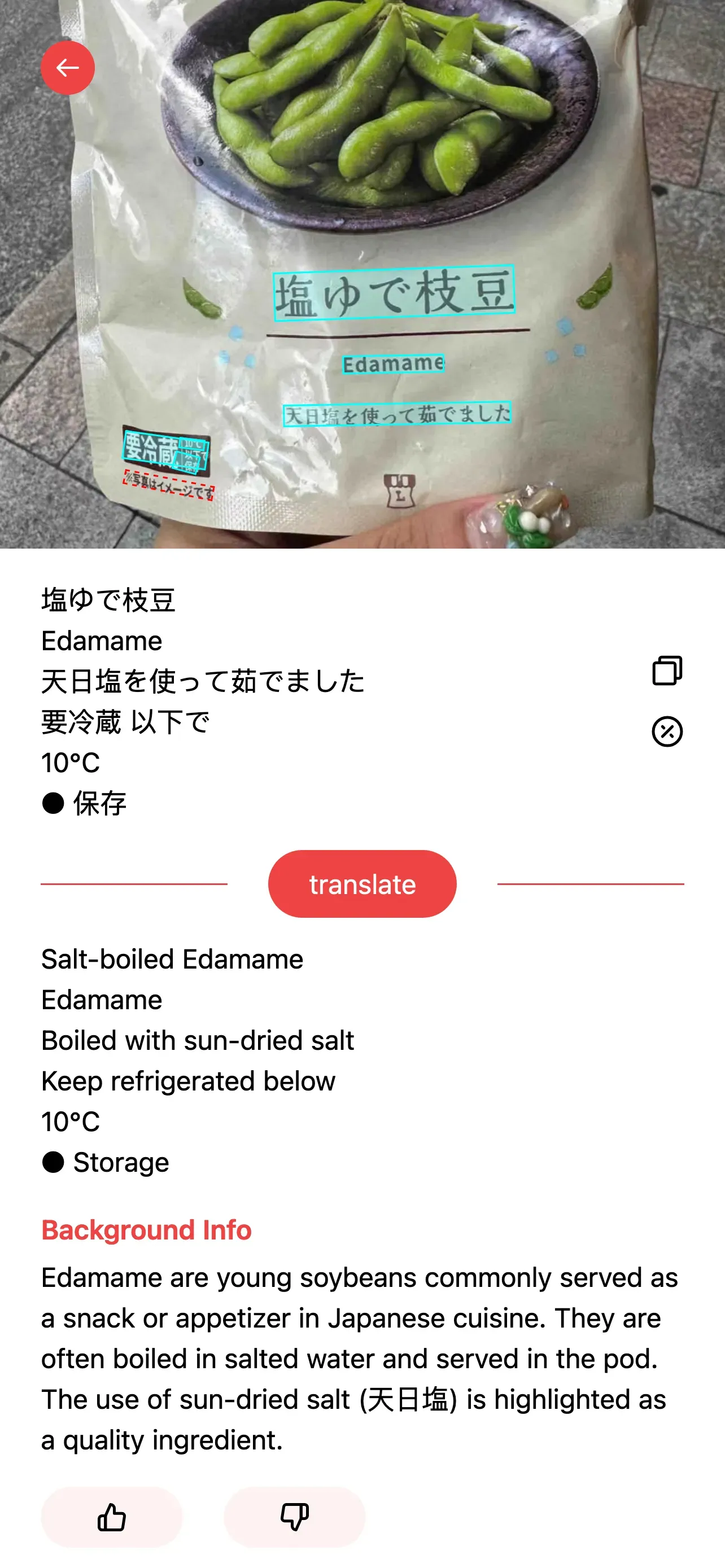 | 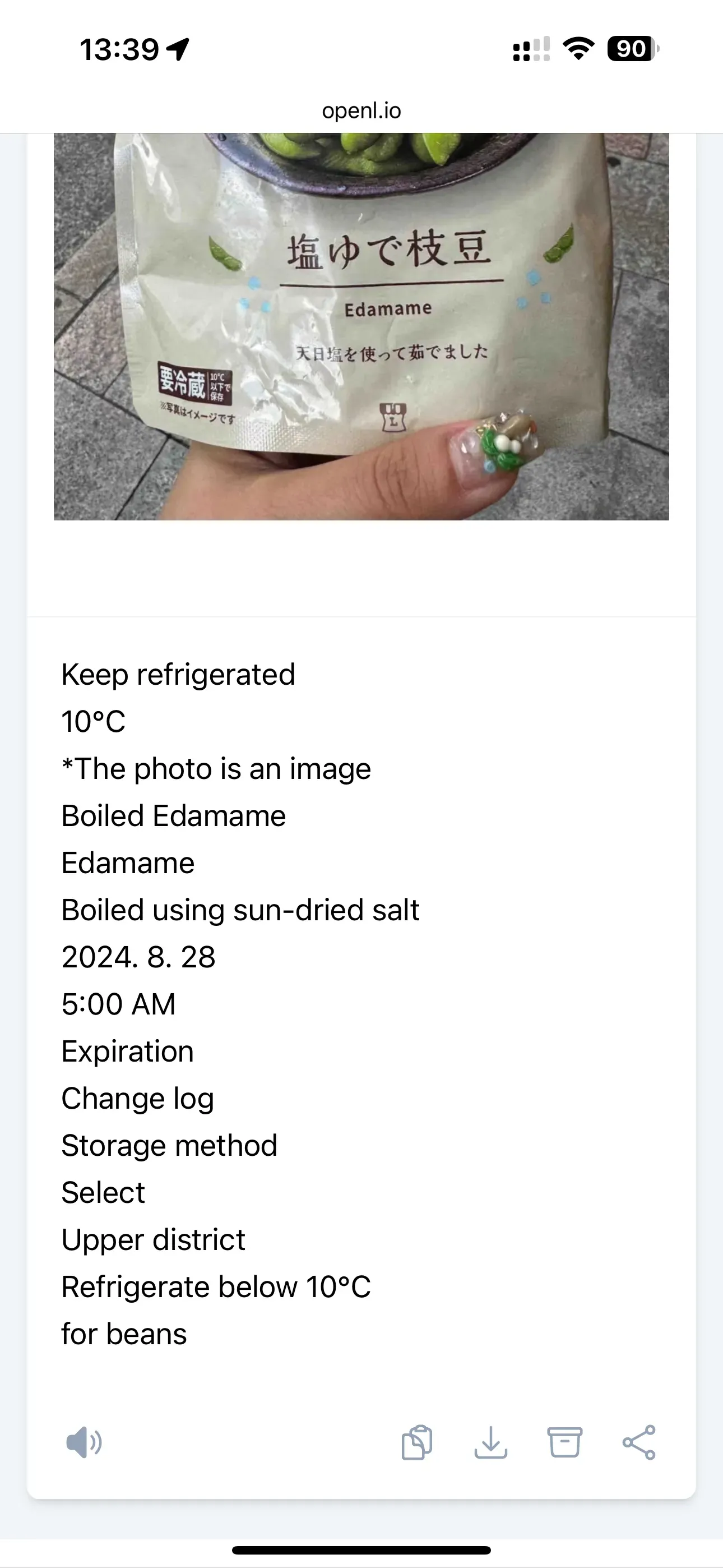 | 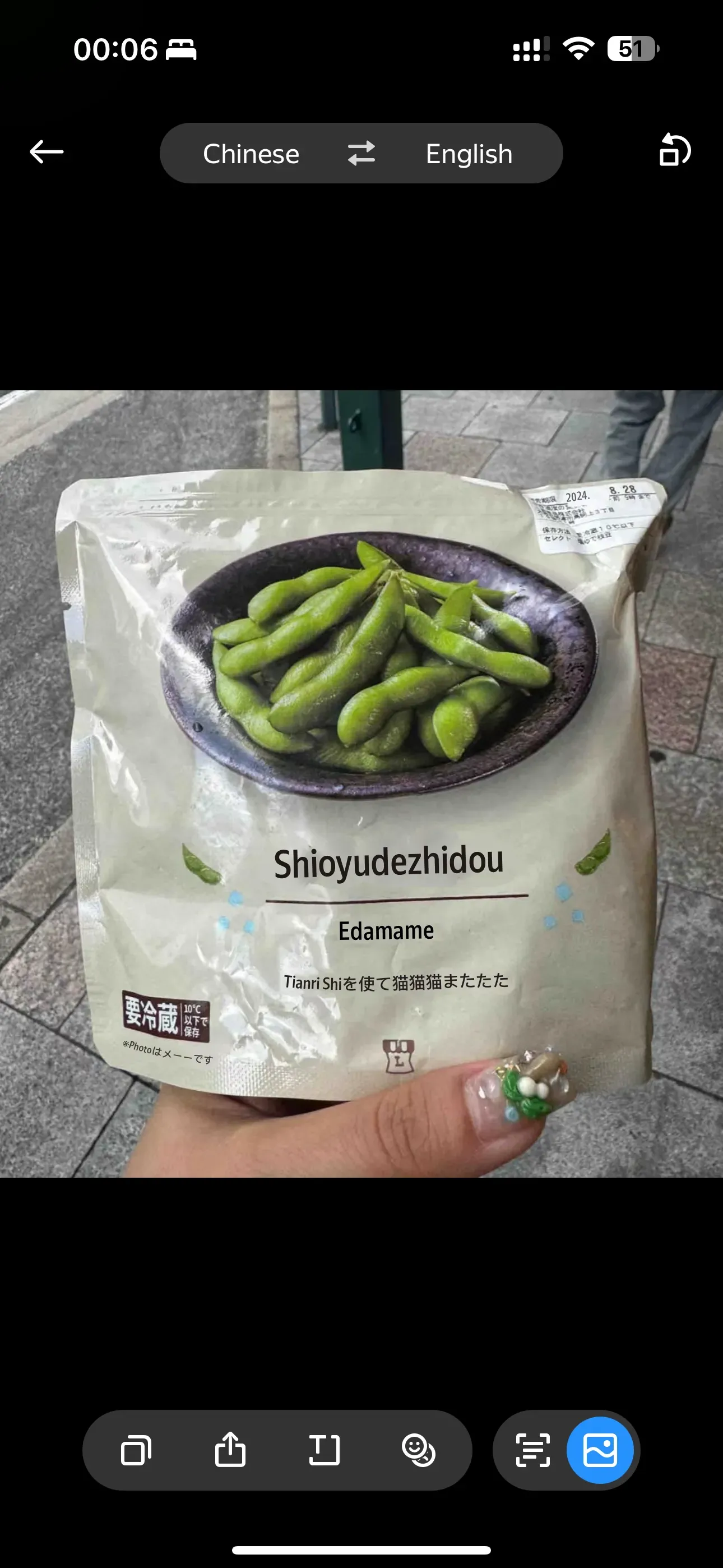 |
Here's how each translator performed overall:
| Tool | Performance |
|---|---|
| ✓ Gets the basics right | |
| Photolate | ✓ Clear and detailed |
| OpenL | ✓ Clear and accurate |
| Yandex | 🚫 Still struggling with basic text recognition |
The real difference shows up in translating "天日塩を使って茹でました":
- Google: "Boiled with sun-dried salt" (Gets the point across)
- Photolate: "Boiled with natural sun-dried salt" (Gets the point across)
- OpenL: "Boiled using sun-dried salt" (Pretty close!)
- Yandex: "TianriShiを使て猫猫猫またたた" (Um... what?)
Quick Takeaway
- Just need the basics? Google's got you.
- Want the full story? Photolate is your friend.
Fun Fact
"天日" means natural sunlight - that tiny detail makes all the difference in understanding traditional Japanese food preparation.
Test 3. The Medicine Cabinet Mystery 💊
When you're feeling under the weather in Japan, understanding medicine labels becomes crucial. Let's see how our translation tools handle a common cold medicine label.

Translation Face-Off
| Google Translate | Photolate | OpenL Translate | Yandex Translate |
|---|---|---|---|
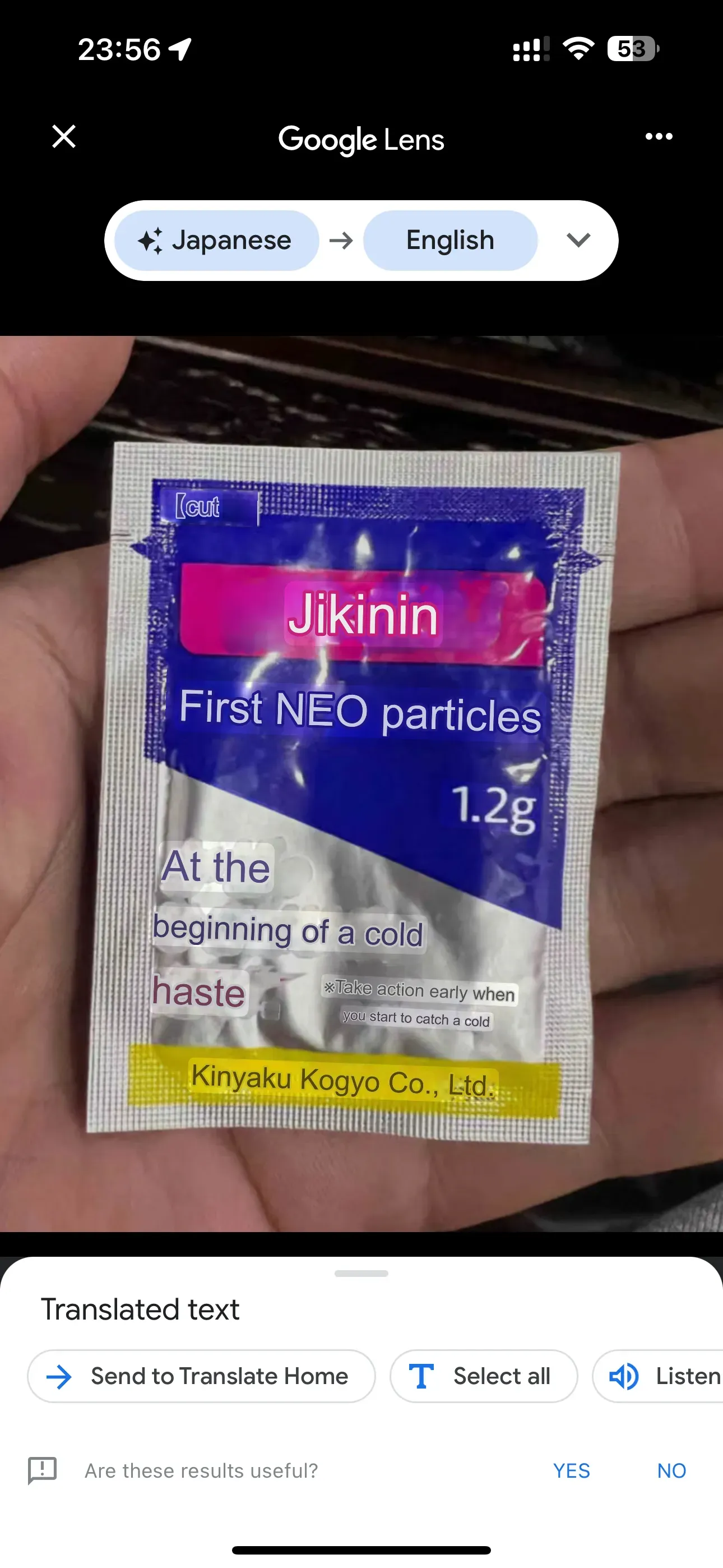 | 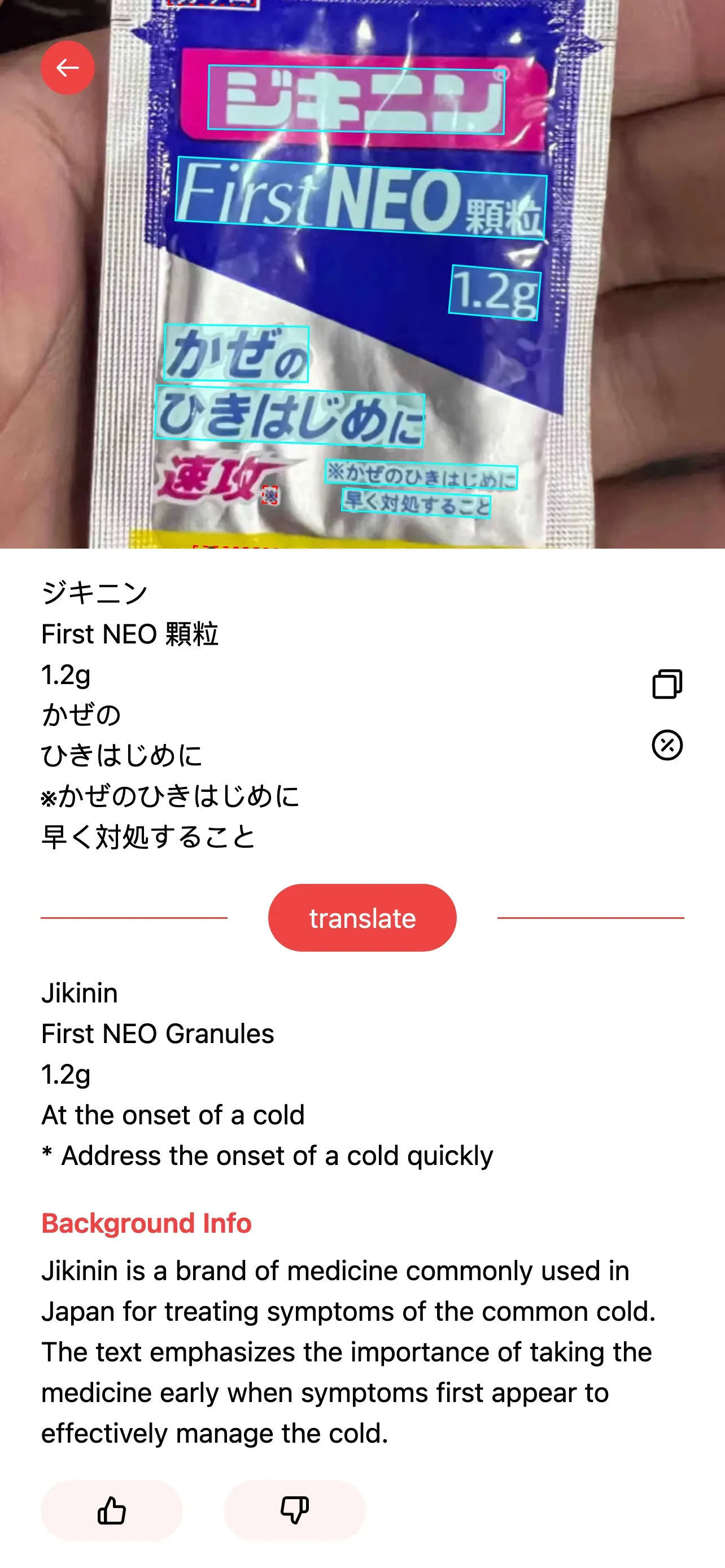 | 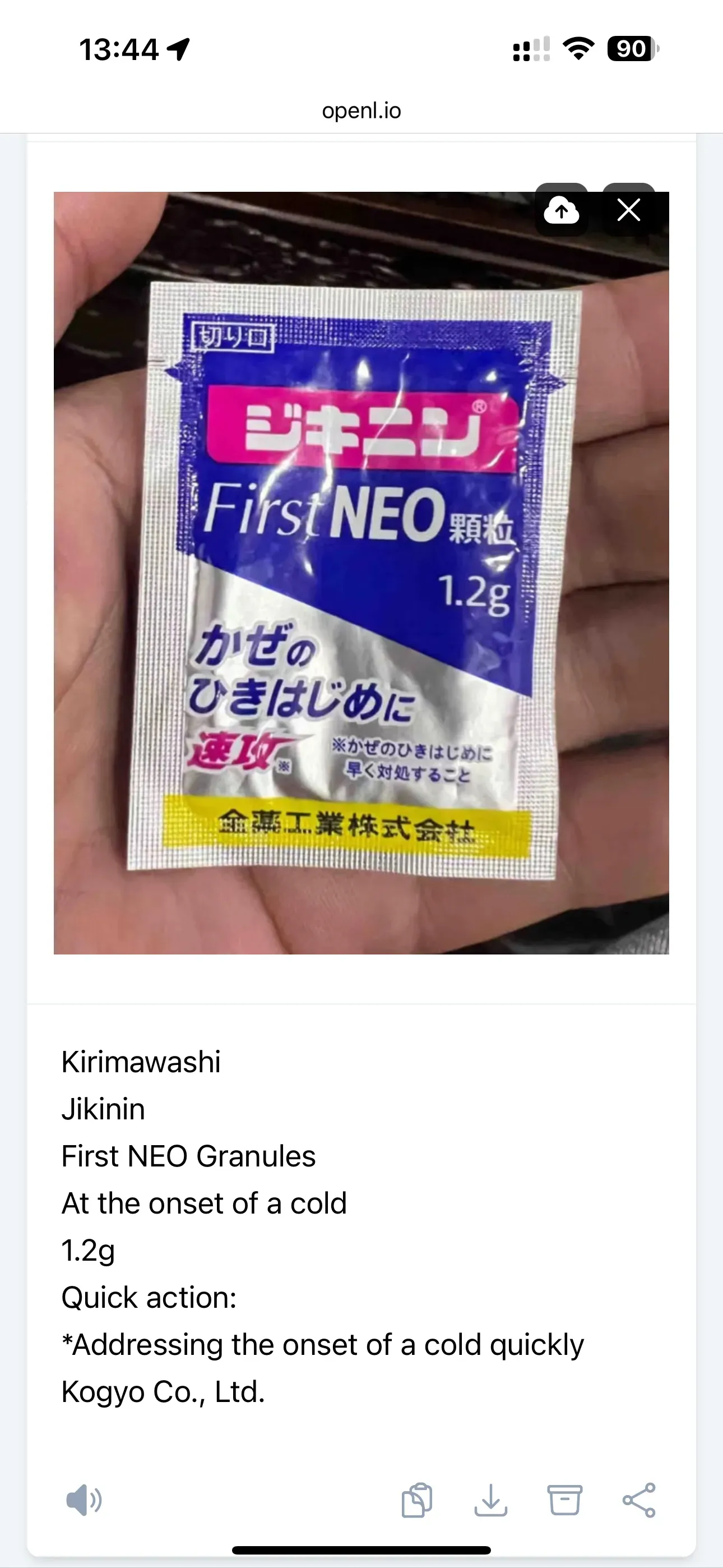 | 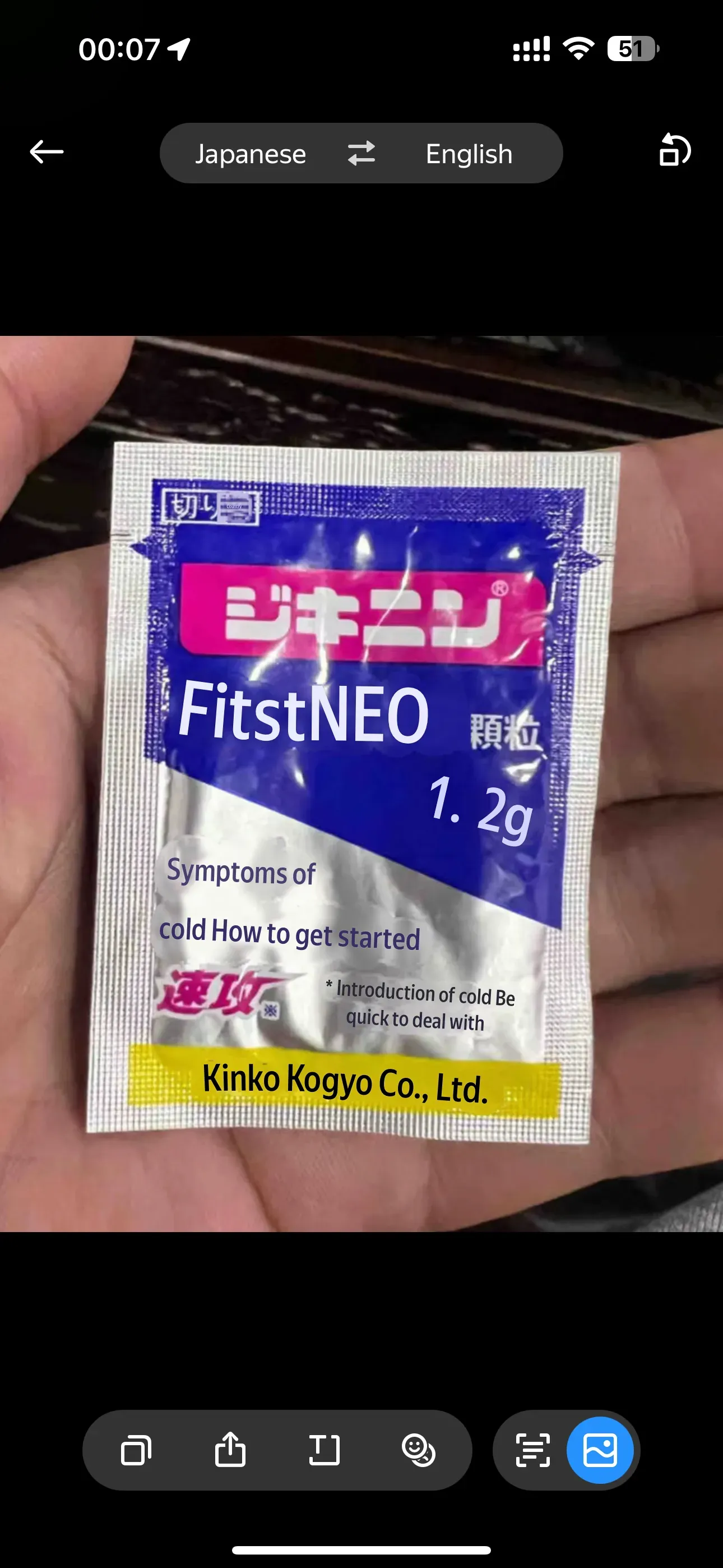 |
For a detailed comparison of the translations, here's a breakdown:
| / | Google translate | Photolate | openL | yandex |
|---|---|---|---|---|
| 切り口 | Cut | Cut edge | Kirimawashi | / |
| ビキニン | jikinin | Bikinine | Jikinin | / |
| FirstNEO顆粒 | First NEO particles | FirstNEO granules | First NEO Granules | / |
| かぜの ひきはじめに | At the beginning of a cold | At the first signs of a cold | At the onset of a cold | Symptoms of cold How to get started |
| ※かぜのひきはじめに早く対処すること | *Take action early when you start to catch a cold | Address the first signs of a cold promptly | *Addressing the onset of a cold quickly | * Introduction of cold Be quick to deal with |
Google Translate: The Basics Covered
- Captures essential meaning
- Gets the job done for simple instructions
- Good for basic understanding
Photolate: 8/10
- Accurate medical terminology
- "At the first signs of a cold" (Clear medical instructions)
- "FirstNEO granules" (Proper pharmaceutical format)
OpenL: Strong Runner-Up (8/10)
- Generally accurate
- "At the onset of a cold" (Accurate but less common phrasing)
- Good enough for basic understanding
Yandex Translate: ❌
- Still struggles with basic text recognition
Quick Take
For medicine labels, accuracy is everything. While Google Translate can help you get the gist, it's always best to double-check important medical information.
Safety Tip
When in doubt about medication, always double-check with a pharmacist!
Test 4. Decoding Street Signs 🏯
Japan's public transport? Usually English-friendly. But step off the beaten path, and you're in a world of Japanese-only signs.
The Shrine Sign Challenge Let's crack a typical street sign pointing to Tsuyuten Shrine. Seems simple, right? Well...

| Google Translate | Photolate | OpenL Translate | Yandex Translate |
|---|---|---|---|
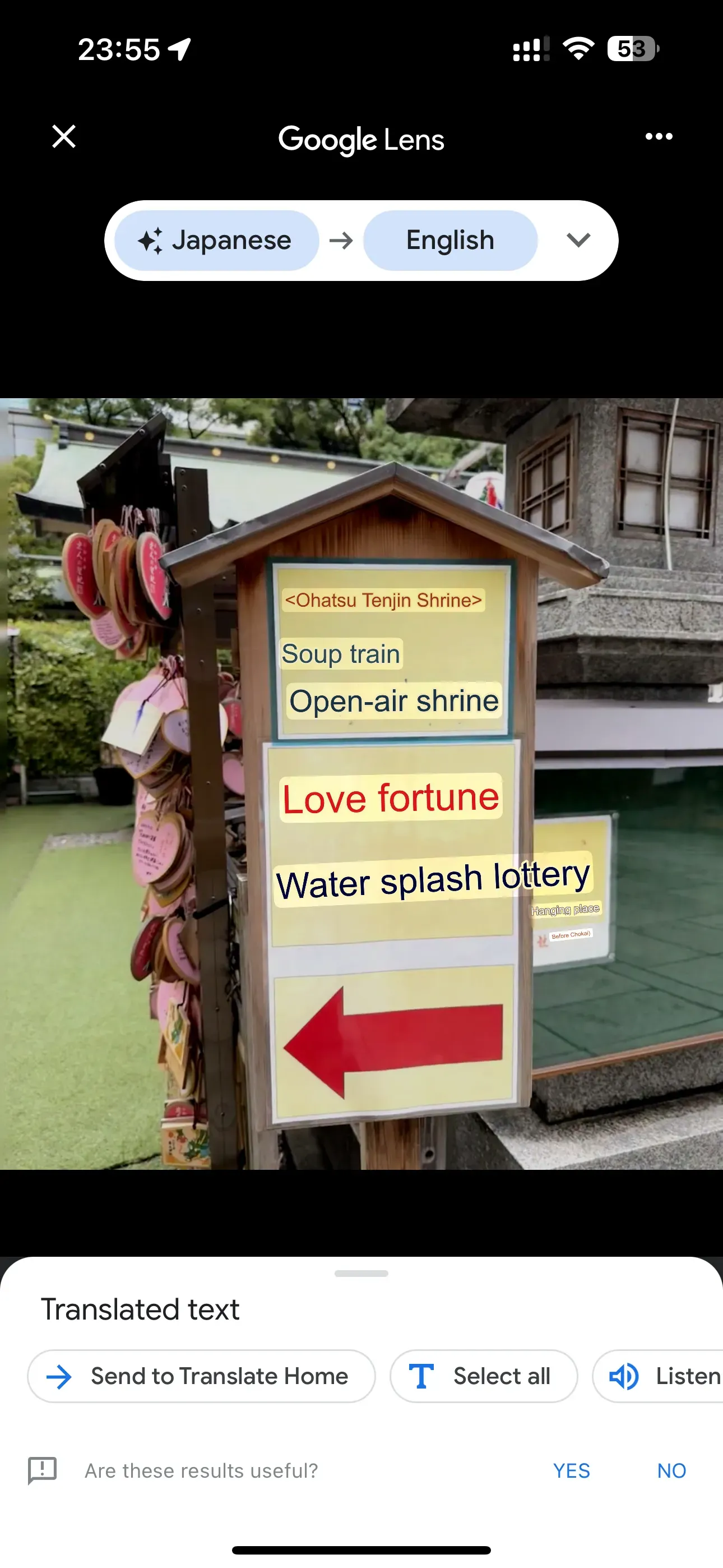 | 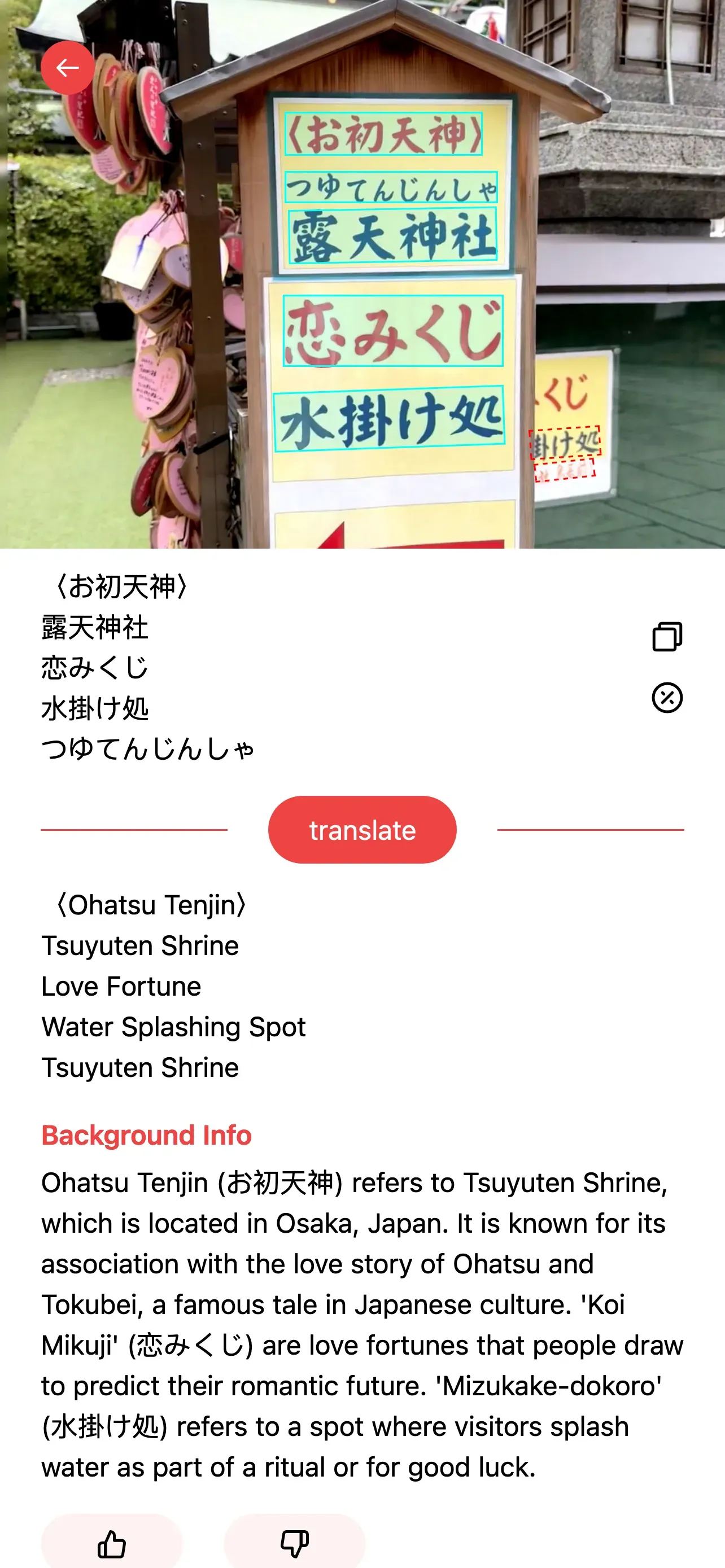 | 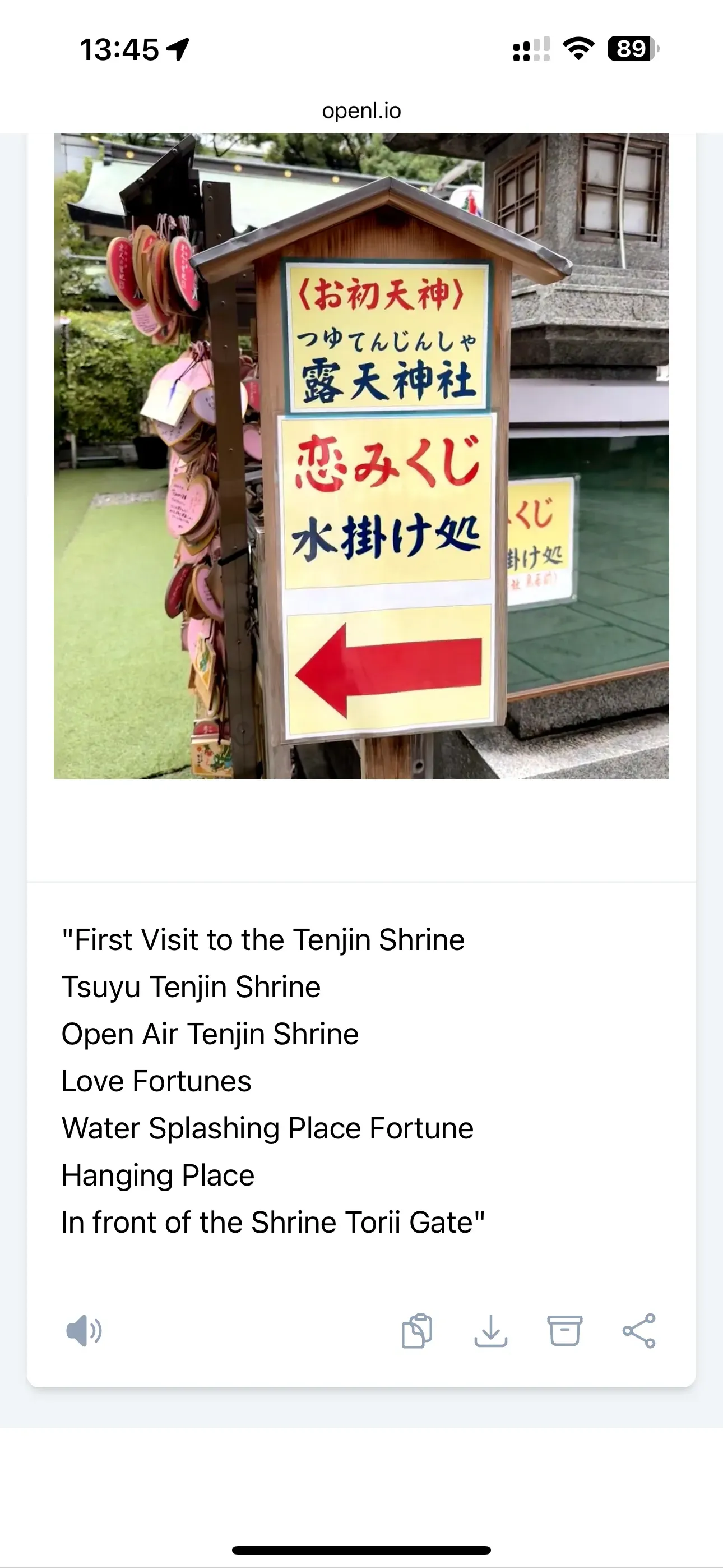 | 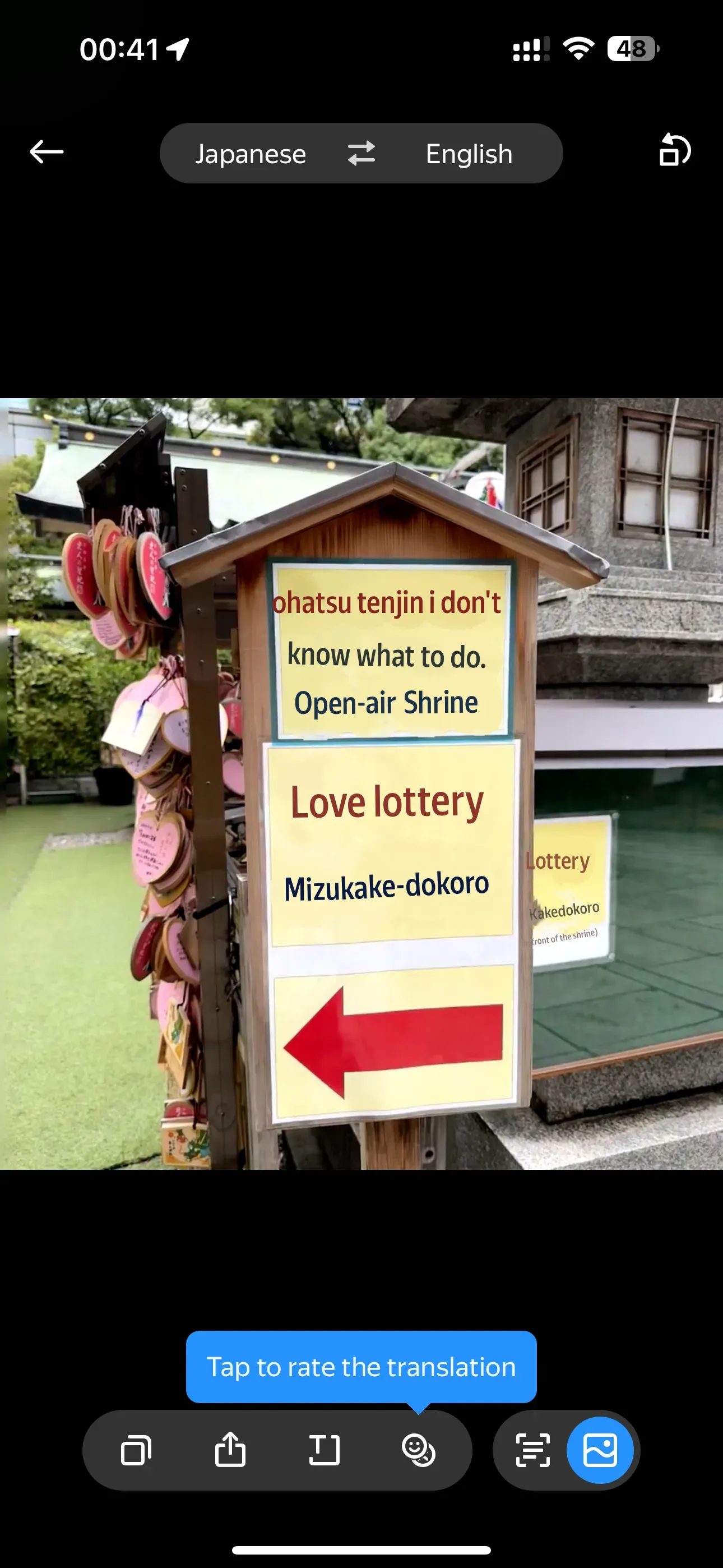 |
Translation Results
Google Translate & OpenL:
- Provided literal translations that missed cultural context
- "Soup train"?
- "Love fortune and water splash lottery"?
Photolate:
- Captured the cultural meaning
- Recognized the shrine's formal and informal names
- Provided context for traditional elements
The Cultural Context
Here's what's really going on:
- お初天神 (Ohatsu Tenjin) - The shrine's nickname
- つゆてんじんしゃ (Tsuyutenjinsha) - Its formal Japanese name
- 露天神社 - Same shrine in kanji characters
Cool fact
This shrine is famous for a legendary love story. That's why you'll find:
- 恋みくじ - Love fortune slips (not lottery tickets!)
- 水掛け処 - A special spot for water-pouring wishes (not a water splash game!)
Understanding these cultural elements makes a big difference in getting the right meaning!
Test 5. The Ultimate Test: Omikuji Fortune Slips 🎋
When visiting the famous Kiyomizu-dera temple in Kyoto, you'll likely encounter omikuji - those mysterious paper fortunes packed with intricate Japanese text and traditional predictions.
Now it's time for our translation tools to face their ultimate challenge: decoding these complex spiritual messages!
The Challenge
Imagine holding this paper full of characters. Is it good luck? Bad luck? And what's all that tiny text about?

| Google Translate | Photolate | OpenL Translate | Yandex Translate |
|---|---|---|---|
 | 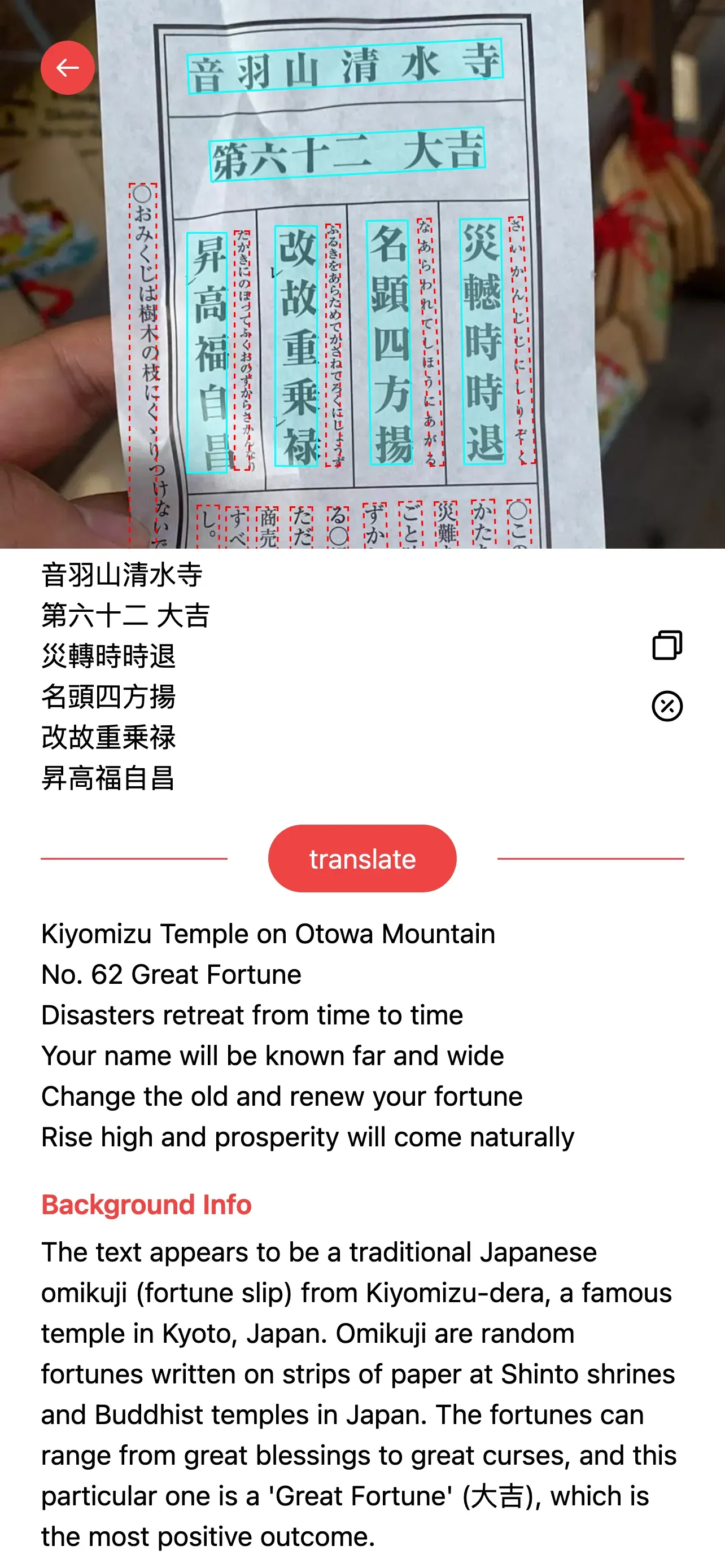 | 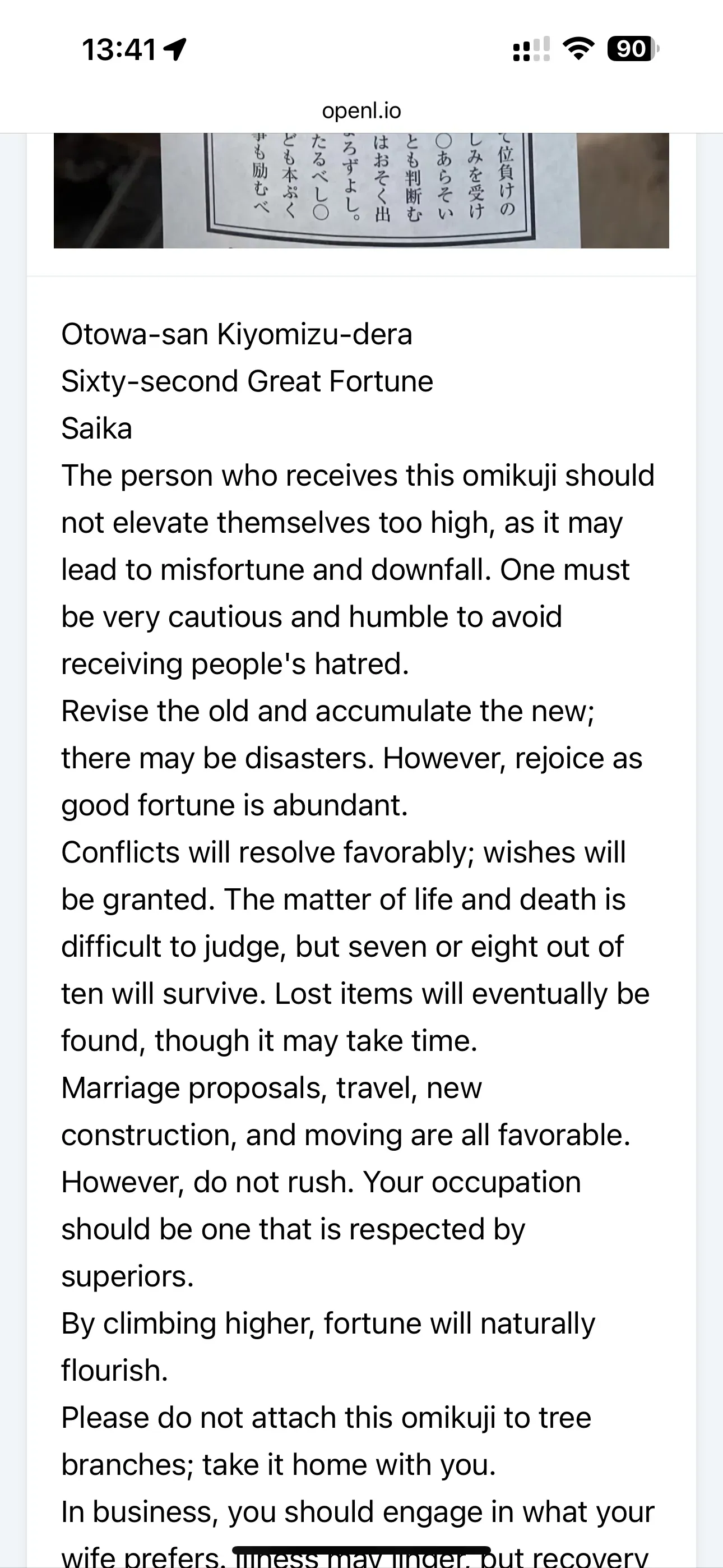 | 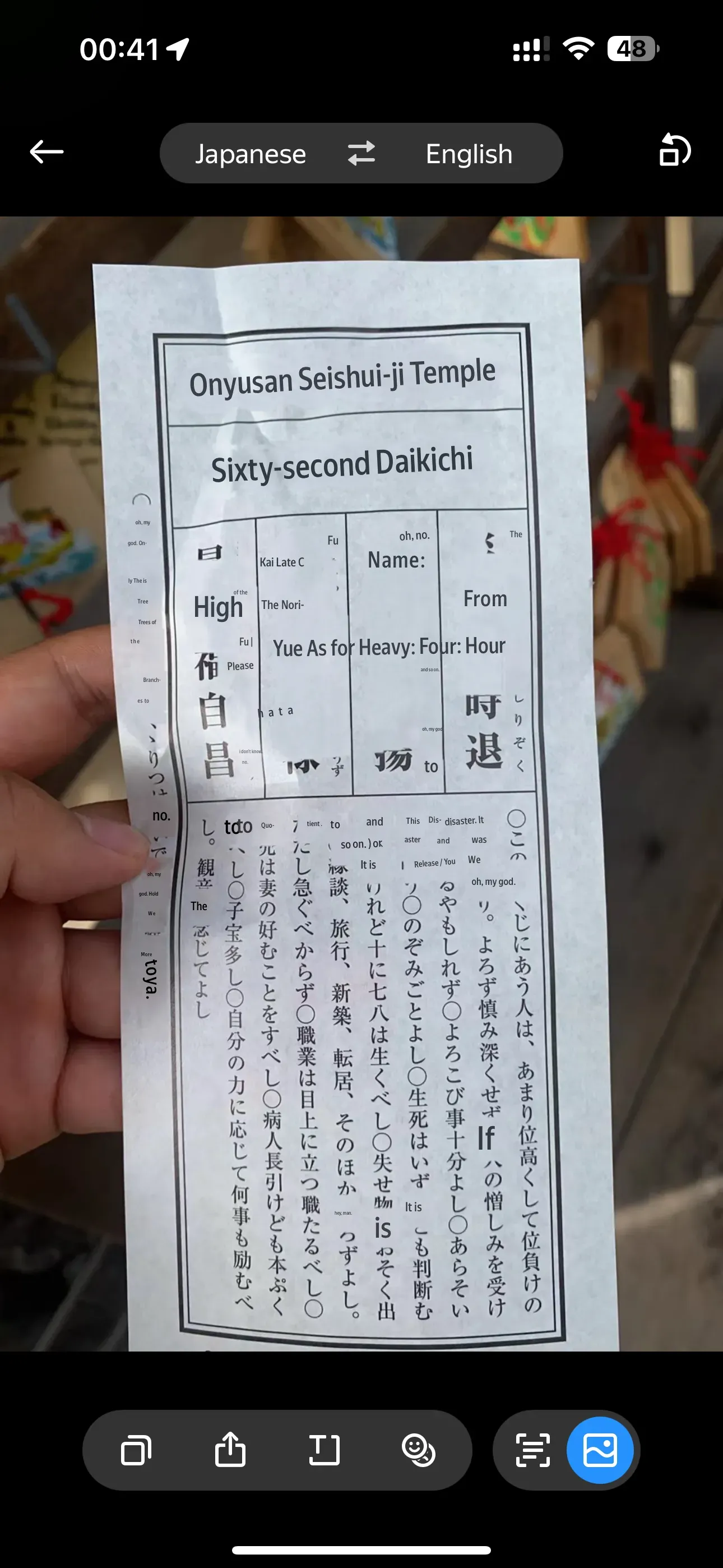 |
Tool Performance
Google Translate
- Gets the basic fortune level
- Leaves you guessing about details
- Lost in the poetic language
OpenL
- Better than Google
- Still misses cultural nuances
- Makes you wonder if you're reading it right
Photolate: The Smart Approach
- Clever Feature: Starts with the main text (your fortune level)
- Accurate: Nails both meaning and cultural context
- Interactive: Click to reveal more details if you're curious
| Default View | Click to reveal more details |
|---|---|
 | 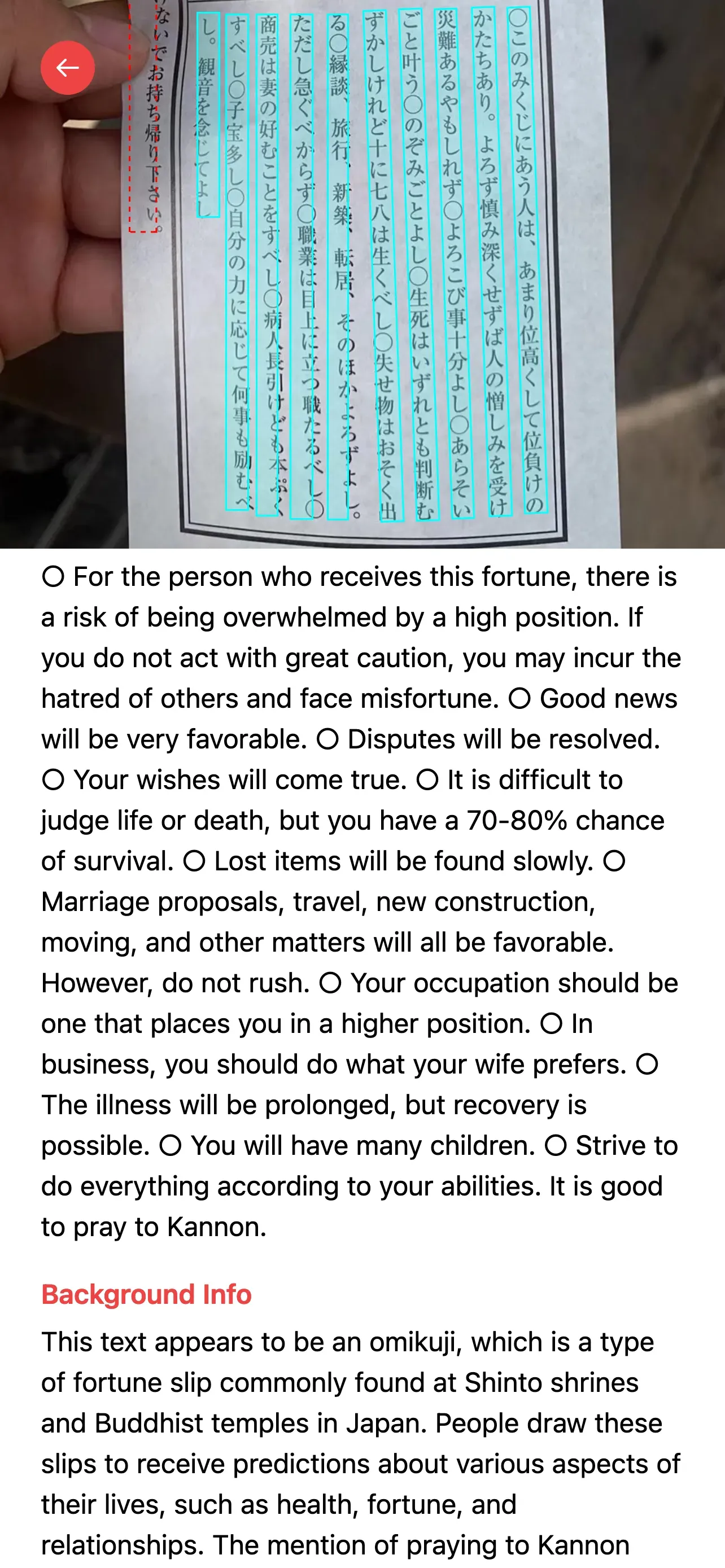 |
Yandex
Still struggles with OCR, failing to even recognize basic Japanese characters. The results were so poor we couldn't include it in our detailed comparison.
Fun Fact
Traditional omikuji aren't just "good" or "bad" luck - they have subtle levels and specific advice for everything from love to travel!
Test Results Compared 🏆
After putting our tools through five real-world tests, here's what we learned:
Round 1: Text Recognition 👀
The first and most crucial step for any Japanese image translator is accurate text recognition - without it, even the best translation engine would fail.
Google Translate (6/10)
- Adequate for basic recognition
- Sometimes misses characters
- Translation quality depends on recognition accuracy
Photolate (9/10)
- Excellent with handwritten text
- Shows recognized text locations
- Lists recognized text top-to-bottom
- Handles both printed and handwritten characters well
OpenL (8/10)
- Good text recognition accuracy
- Doesn't show text locations
- Translation matching can be challenging
Yandex
- Struggles with basic Japanese text recognition
Round 2: Translation Quality 🎯
Google Translate: The Basic Helper
- Reliable for simple phrases
- May miss cultural context
- Tends toward literal translations
Photolate
- Strong contextual understanding
- Includes cultural context
- Provides background information
- Natural translation style
OpenL: The Reliable Runner-up
- Accurate translations
- Some cultural context missing
- Good for straightforward translations
Bottom Line
Real-world testing showed just how important accurate translations are - imagine ordering "red eye system" when you wanted "red snapper sashimi"! These kinds of mix-ups can lead to some pretty awkward situations.
While each tool has its strengths, if accuracy and cultural context matter to you, Photolate is worth trying - and it's free to start.
For casual travelers who just need basic help, Google Translate's simple functionality should do the job.
Your Japan Translation Strategy 🗺️
Best Free Option: Google Translate
- Gets the job done for basic stuff
- Always free
- Good enough for common items
Best Overall: Photolate
- Best at understanding Japanese culture
- Excellent text recognition
- Start for free, and pay-as-you-go
Remember
No translation tool is perfect, but having one is better than staring blankly at Japanese text!
